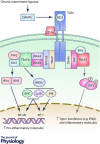Mechanisms of microglial activation in models of inflammation and hypoxia: Implications for chronic intermittent hypoxia
- PMID: 26890698
- PMCID: PMC4799985
- DOI: 10.1113/JP271502
Mechanisms of microglial activation in models of inflammation and hypoxia: Implications for chronic intermittent hypoxia
Abstract
Chronic intermittent hypoxia (CIH) is a hallmark of sleep apnoea, a condition associated with diverse clinical disorders. CIH and sleep apnoea are characterized by increased reactive oxygen species formation, peripheral and CNS inflammation, neuronal death and neurocognitive deficits. Few studies have examined the role of microglia, the resident CNS immune cells, in models of CIH. Thus, little is known concerning their direct contributions to neuropathology or the cellular mechanisms regulating their activities during or following pathological CIH. In this review, we identify gaps in knowledge regarding CIH-induced microglial activation, and propose mechanisms based on data from related models of hypoxia and/or hypoxia-reoxygenation. CIH may directly affect microglia, or may have indirect effects via the periphery or other CNS cells. Peripheral inflammation may indirectly activate microglia via entry of pro-inflammatory molecules into the CNS, and/or activation of vagal afferents that trigger CNS inflammation. CIH-induced release of damage-associated molecular patterns from injured CNS cells may also activate microglia via interactions with pattern recognition receptors expressed on microglia. For example, Toll-like receptors activate mitogen-activated protein kinase/transcription factor pathways required for microglial inflammatory gene expression. Although epigenetic effects from CIH have not yet been studied in microglia, potential epigenetic mechanisms in microglial regulation are discussed, including microRNAs, histone modifications and DNA methylation. Epigenetic effects can occur during CIH, or long after it has ended. A better understanding of CIH effects on microglial activities may be important to reverse CIH-induced neuropathology in patients with sleep disordered breathing.
© 2016 The Authors. The Journal of Physiology © 2016 The Physiological Society.
Figures

References
-
- Akinnusi M, Jaoude P, Kufel T & El‐Solh AA (2013). Toll‐like receptor activity in patients with obstructive sleep apnea. Sleep Breath 17, 1009–1016. - PubMed
-
- Almendros I, Montserrat JM, Ramirez J, Torres M, Duran‐Cantolla J, Navajas D & Farre R (2012). Intermittent hypoxia enhances cancer progression in a mouse model of sleep apnoea. Eur Respir J 39, 215–217. - PubMed
-
- Atalaia A, De Carvalho M, Evangelista T & Pinto A (2007). Sleep characteristics of amyotrophic lateral sclerosis in patients with preserved diaphragmatic function. Amyotroph Lateral Scler 8, 101–105. - PubMed
Publication types
MeSH terms
Substances
Grants and funding
LinkOut - more resources
Full Text Sources
Other Literature Sources
Medical

